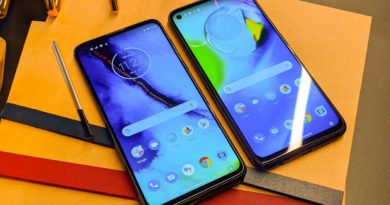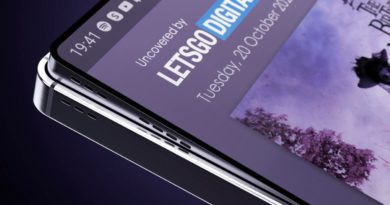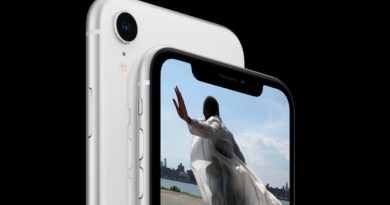Motorola Razr 5G vs Motorola Razr 2019: Here’s the biggest changes
![]()
Will the second time be the charm for the Motorola Razr? That’s surely what the company is hoping, after it pushed out its first revival of the classic flip phone earlier this year to middling reviews. While the Razr foldable certainly benefited from a bit of retro charm, it was simply too inconsistent in build quality, performance and features to justify its astronomical price.
But foldable phones are getting better, as Samsung has demonstrated by consistently improving upon its foldable devices with successive iterations. The second-generation Motorola Razr, now with 5G connectivity, aims to stamp out the original’s flaws, while also coming in at price that is still high, albeit slightly easier to stomach. In this Motorola Razr 5G vs. Motorola Razr 2019 face-off, we’ll outline the biggest differences between between the first flip phone and its replacement.
Motorola Razr 5G vs. Razr 2019: Price and release date
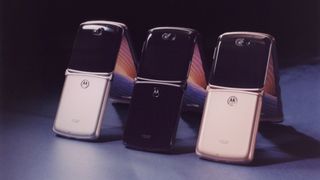
Motorola hasn’t told us when we’ll be able to purchase the new Razr yet, though we do know how much the phone will cost: $1,399. That’s $100 less expensive than the first Razr was when it launched, which is sure to sprinkle yet more salt in the wounds of people who purchased the first-generation foldable, which released not even 10 months ago. It’s also $50 cheaper than the Samsung Galaxy Z Flip 5G.
Whereas the first Razr was exclusive to Verizon, the new model is mercifully available unlocked, and will be sold through AT&T and T-Mobile. Interestingly, Verizon isn’t carrying the new Razr, likely because it cannot connect to Verizon’s predominantly millimeter-wave flavor of 5G.
The first Razr was available in either Noir Black or Blush Gold, but the new model replaces Noir Black with two new shades: Polished Graphite (most similar to black), and Liquid Mercury (more like a silver). Blush Gold returns once more.
One more note on the subject of pricing: Motorola has slashed the price of the existing Razr to $999 on its own website. Even with the price cut, the phone’s Verizon exclusivity makes it almost impossible to recommend for everyone, though it’s perhaps worth entertaining if the upgrades in the new model aren’t all that compelling to you.
Motorola Razr 5G vs. Razr 2019: Design
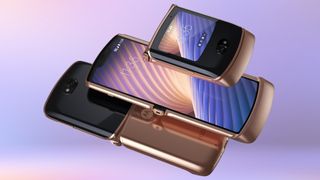
If you’re not intimately familiar with the design of Motorola’s first foldable Razr, you may not be able to tell the first- and second-generation models apart. There are some giveaways, however, if you know where to look.
Firstly, with the new Razr shut, we can see it has a redesigned camera module with a more tapered chin that no longer houses a capacitive fingerprint sensor. Instead, that module now resides on the back. Speaking of the back, it’s now clad in 3D glass on the new model — a marked improvement over the unpleasant, chintzy-feeling stippled plastic of the first attempt. A 7000-series aluminum frame should hopefully help lend an even more solid, premium feel to a device that previously didn’t feel all that solid or premium.

Overall, Motorola says the hinge on the new Razr is rated to withstand 200,000 flips, which should last the average user five years by the company’s estimation. The hinge on the first Razr was known to creak and generally be hard to open with one hand, though Motorola says it has made efforts to mitigate these issues. Additionally, a new teardrop curvature to the folding element of the screen should help the device close fully flush, compared to the disconcerting gaps of the company’s earlier rendition.
Having not tested the new Razr yet, we can’t speak to how successful Motorola has been in making the new Razr feel more solid and generally better put-together than its predecessor. For that, you’d best stay tuned for our hands-on impressions, where we’ll put those claims to the test.
Motorola Razr 5G vs. Razr 2019: Displays

The new Razr’s interior 6.2-inch and exterior 2.7-inch displays have been pretty much unchanged in this revision. The large folding screen is still protected by layers of plastic, rather than Samsung’s Ultra Thin-Glass. That doesn’t instill the most confidence in the world, given Motorola’s mantra of “bumps and lumps” being normal in the lead up to the first Razr’s release.
Indeed, we did encounter our share of bumps and lumps when we reviewed the first foldable Razr back in the early part of this year, noticing an orange-peel effect pervading the display and drawing attention to a hard-to-ignore circular depression in the top half of the panel. To lessen the chances of this, and make the display feel more natural in general, Motorola says it’s pulled the Razr’s screen more tightly over the metal support plates behind it.
The overall look and feel of the Razr’s folding screen was one of its most egregious shortcomings, so we certainly hope an improvement has been made to that aspect regarding the new model.

While the 2.7-inch Quick View display on the Razr 5G’s exterior is identical to the one in the original handset, users will now be able to do far more with it than simply glance at notifications and summon the Google Assistant. The Quick View panel can now run any app, and while that might seem like a bad idea on such a small screen, Motorola says Razr users love the convenience of the phone’s exterior screen and have actively asked to employ it for as many apps as possible.
And so the new Quick View experience supports everything from placing phone calls to Google Maps navigation and playback controls for practically any music streaming app you can imagine. And if you’re daring enough to attempt to run YouTube on that tiny 2.7-inch canvas, well, that’s your prerogative — Motorola isn’t going to stop you.
Motorola Razr 5G vs. Razr 2019: Cameras
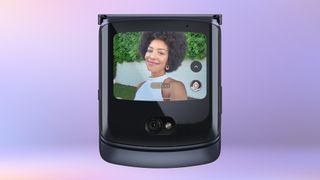
Motorola has never been a company renowned for its imaging technology, but the single-lens, 16-megapixel shooter on the exterior of the first Razr was really quite poor. There are budget phones that capture better pictures, especially in low light, and the results from Motorola’s foldable were downright embarrassing compared to other options in the $1,000-plus price range.
Thankfully, the new Razr’s camera has seen a serious step up, from 16MP to 48MP. Optical image stabilization and laser autofocus are now also on tap, which should greatly improve the Razr’s ability to both capture a steady shot and ensure the subject is properly in focus. Above the display on the inside of the phone, you’ll find a 20MP shooter which collects four times the megapixels of the paltry 5MP sensor in the original Razr.
However, if you want the best possible selfies, your safest bet is to use that main 48MP camera with the Quick View display serving as your viewfinder. Motorola claims the Razr will be one of the best handsets for capturing selfies on the market, given that its main camera can be used for such things. That’s indeed a unique advantage most phones cannot lay claim to.
Motorola Razr 5G vs. Razr 2019: Specs
| Motorola Razr 5G | Motorola Razr 2019 | |
|---|---|---|
| Price | $1,399 | $1,499 |
| Interior display | 6.2 inches OLED (2142×876) | 6.2 inches OLED (2142×876) |
| Exterior display | 2.7 inches OLED (800×600) | 2.7 inches OLED (800×600) |
| CPU | Snapdragon 765G | Snapdragon 710 |
| RAM | 8GB | 6GB |
| Storage | 256GB | 128GB |
| Rear cameras | 48MP (ƒ/1.7) | 16MP (ƒ/1.7) |
| Front camera | 20MP (ƒ/2.2) | 5MP (ƒ/2.0) |
| Battery | 2,800 mAh | 2,510 mAh |
| Size (folded) | 3.6 x 2.9 x 0.63 inches | 3.7 x 2.83 x 0.55 inches |
| Size (open) | 6.7 x 2.9 x 0.31 inches | 6.77 x 2.83 x 0.27 inches |
| Weight | 6.77 ounces | 7.2 ounces |
Motorola Razr 5G vs. Razr 2019: Performance

Aside from the camera hardware, one of the Razr 5G’s biggest improvements concerns its specs. The first-generation device was hampered by a Snapdragon 710 processor, which, while serviceably fast, wasn’t quite up to the level of performance someone dropping $1,500 on a phone would probably prefer. That device also made do with just 6GB of RAM and 128GB of storage, which is also quite underwhelming for the price.
Fortunately, Motorola has stepped up the new Razr’s internals in a big way. The Snapdragon 765G chipset inside the new device isn’t merely faster than the silicon it replaces — it also enables low- and mid-band 5G connectivity. Couple that with an upgrade to 8GB of RAM and 256GB of storage, and it seems as though the second-gen Razr will make far less concessions to performance than its predecessor, despite the fact it’s $100 cheaper.
The Snapdragon 765G has performed admirably in phones like the OnePlus Nord and LG Velvet. For an idea of the caliber of performance you can expect from the new Razr, the OnePlus Nord delivered 1,948 points in the multi-core portion of the system-wide Geekbench 5 benchmark, while the Snapdragon 710-powered first-gen Razr topped out at 1,406 points.
Both are still a ways away from the 3,294 points of a Snapdragon 865 Plus-powered device like the $1,299 Samsung Galaxy Note 20 Ultra, though the 765G should still offer enough grunt for regular users who aren’t playing the most demanding mobile games.
Motorola Razr 5G vs. Razr 2019: Battery
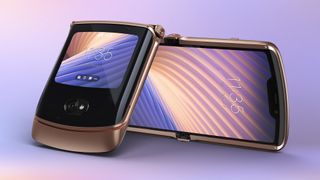
You can only fit a battery so large in a device as compact as the Razr. Thus, it was unsurprising how badly the original model struggled with longevity on a charge, lasting just over 6 hours in Tom’s Guide’s custom battery test as a consequence of its tiny 2,510-mAh power pack. The latest iPhones and Galaxy Note devices tend to fall between 9 and 11 hours, so the Razr’s showing was unfortunately disappointing for the price.
For the new Razr, that capacity has been upgraded to 2,800 mAh, which should help support the new phone’s slightly more power-hungry 5G radios. Motorola also tells us Razr users tend to eke better endurance out of their devices on a daily basis than they might with a conventional phone, thanks to the Quick View display’s suitability for glanceable notifications that don’t force you to wake the main display as often. That’ll perhaps be of some consolation to any prospective Razr 5G buyers concerned about making it through the day on a minimum of charges.
Motorola Razr 5G vs. Razr 2019: Outlook
It’s rare to see a phone company release a greatly enhanced version of an existing device less than a year after launch, but that’s exactly what Motorola looks to be doing with the second-generation Razr.
This new foldable looks to be an improvement on the company’s underwhelming first attempt in practically every possible way, from its design, to its cameras, performance and battery life. With 5G connectivity thrown in as well, it comes off as a considerably better value than the original Razr was, at $100 less to boot.
So on paper, it’s clear to see Motorola has put the work in. What remains to be seen is whether those improvements will translate to a Razr that’s better to use in the real world. We look forward to getting our hands on the device to find our for ourselves soon.
